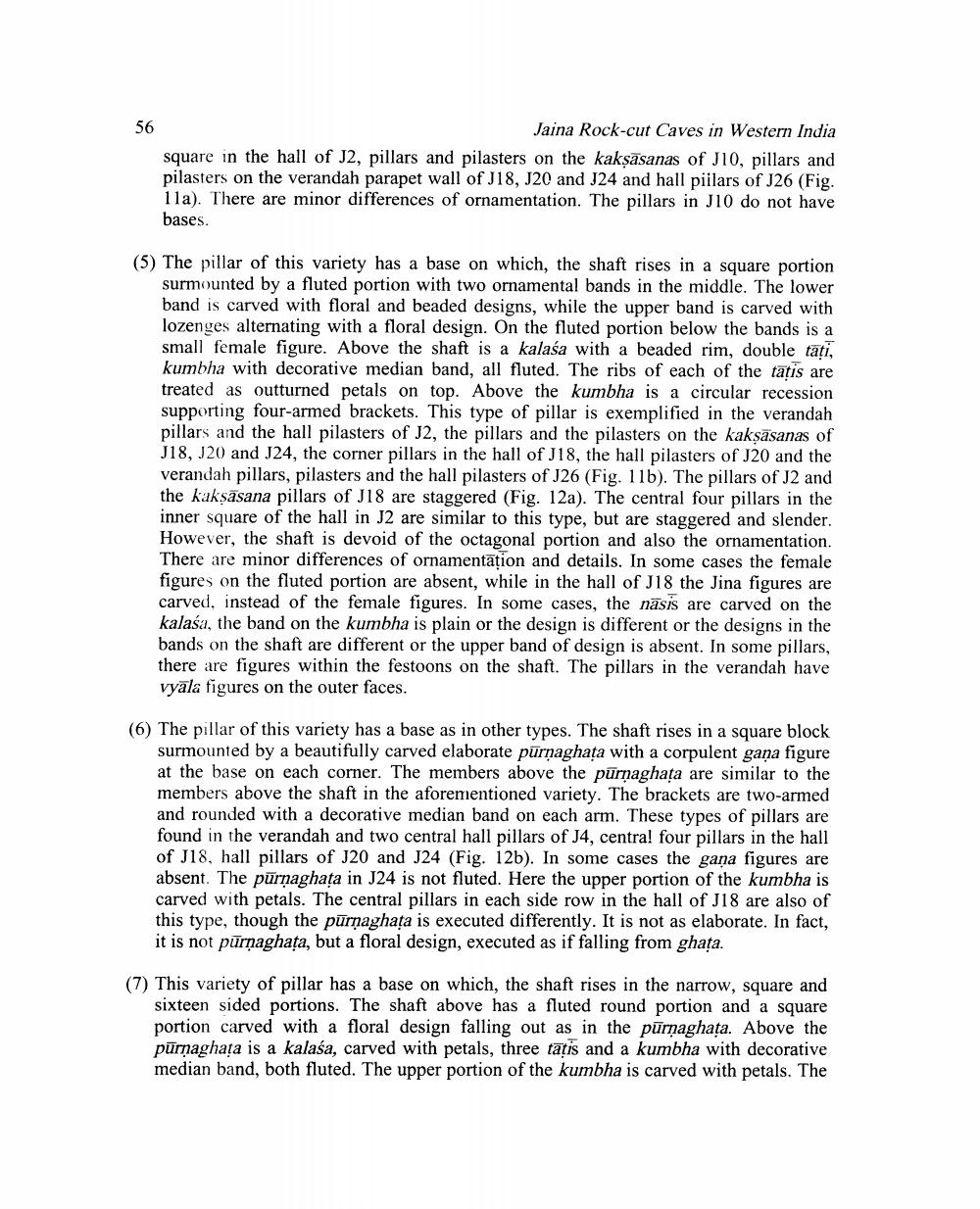________________
56
Jaina Rock-cut Caves in Western India square in the hall of J2, pillars and pilasters on the kakṣasanas of J10, pillars and pilasters on the verandah parapet wall of J18, J20 and J24 and hall piilars of J26 (Fig. 11a). There are minor differences of ornamentation. The pillars in J10 do not have bases.
(5) The pillar of this variety has a base on which, the shaft rises in a square portion surmounted by a fluted portion with two ornamental bands in the middle. The lower band is carved with floral and beaded designs, while the upper band is carved with lozenges alternating with a floral design. On the fluted portion below the bands is a small female figure. Above the shaft is a kalaśa with a beaded rim, double tați, kumbha with decorative median band, all fluted. The ribs of each of the tatis are treated as outturned petals on top. Above the kumbha is a circular recession supporting four-armed brackets. This type of pillar is exemplified in the verandah pillars and the hall pilasters of J2, the pillars and the pilasters on the kakṣäsanas of J18, J20 and J24, the corner pillars in the hall of J18, the hall pilasters of J20 and the verandah pillars, pilasters and the hall pilasters of J26 (Fig. 11b). The pillars of J2 and the kakṣāsana pillars of J18 are staggered (Fig. 12a). The central four pillars in the inner square of the hall in J2 are similar to this type, but are staggered and slender. However, the shaft is devoid of the octagonal portion and also the ornamentation. There are minor differences of ornamentation and details. In some cases the female figures on the fluted portion are absent, while in the hall of J18 the Jina figures are carved, instead of the female figures. In some cases, the nasis are carved on the kalasa, the band on the kumbha is plain or the design is different or the designs in the bands on the shaft are different or the upper band of design is absent. In some pillars, there are figures within the festoons on the shaft. The pillars in the verandah have vyāla figures on the outer faces.
(6) The pillar of this variety has a base as in other types. The shaft rises in a square block surmounted by a beautifully carved elaborate purnaghata with a corpulent gana figure at the base on each corner. The members above the pūrṇaghața are similar to the members above the shaft in the aforementioned variety. The brackets are two-armed and rounded with a decorative median band on each arm. These types of pillars are found in the verandah and two central hall pillars of J4, central four pillars in the hall of J18, hall pillars of J20 and J24 (Fig. 12b). In some cases the gana figures are absent. The purnaghata in J24 is not fluted. Here the upper portion of the kumbha is carved with petals. The central pillars in each side row in the hall of J18 are also of this type, though the purnaghata is executed differently. It is not as elaborate. In fact, it is not purnaghata, but a floral design, executed as if falling from ghata.
(7) This variety of pillar has a base on which, the shaft rises in the narrow, square and sixteen sided portions. The shaft above has a fluted round portion and a square portion carved with a floral design falling out as in the purnaghata. Above the pūrṇaghața is a kalaśa, carved with petals, three tatis and a kumbha with decorative median band, both fluted. The upper portion of the kumbha is carved with petals. The




